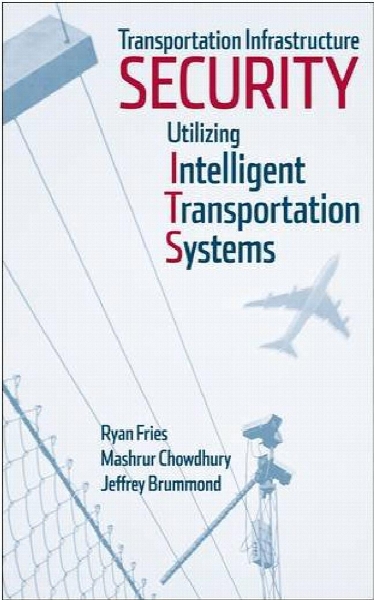Transportation infrastructure security utilizing intelligent transportation systems
- نوع فایل : کتاب
- زبان : انگلیسی
- مؤلف : Ryan Fries; Mashrur A Chowdhury; Jeffrey Brummond
- ناشر : Hoboken : John Wiley
- چاپ و سال / کشور: 2009
- شابک / ISBN : 9780470286296
Description
Preface. Acknowledgments. Chapter 1: Introduction. 1.1 Concept of Security. 1.2 Transportation and Security. 1.3 Security in the ITS Context. 1.4 Scope and Audience of the Book. 1.5 Content and Organization. 1.6 References. 1.7 Review Questions. Chapter 2: Need for Surface Transportation Infrastructure Security. 2.1 Vulnerabilities. 2.2 Common Characteristics of Surface Transportation Systems. 2.3 Common Threats to Surface Transportation Systems. 2.3.1 Earthquakes. 2.3.2 Fires. 2.3.3 Terrorist Attacks. 2.3.4 HAZMAT. 2.3.5 Blackouts. 2.3.6 Hurricanes. 2.3.7 Floods. 2.3.8 Biological and Chemical Attacks. 2.3.9 Derailment. 2.3.10 Cyber Attacks. 2.4 Defending against Threats Both External and Internal. 2.5 Why Transportation Infrastructure Security Is Important. 2.6 Focus Areas. 2.7 Summary. 2.8 References. 2.9 Review Questions. Chapter 3: Leveraging ITS to Reduce Risk and Exposure Using ITS Security Areas. 3.1 Introduction. 3.2 Disaster Response and Evacuation. 3.3 Freight and Commercial Vehicle Security. 3.4 HAZMAT Security. 3.5 ITS Wide Area Alert. 3.6 Rail Security. 3.7 Transit Security. 3.8 Transportation Infrastructure Security. 3.9 Traveler Security. 3.10 Conclusions. 3.11 References. 3.12 Reviews Questions. Chapter 4: Risk Assessment Framework. 4.1 Risk Assessment Framework. 4.1.1 Critical Assets. 4.1.2 Risks Assessment Methods. 4.1.3 Mitigation and Countermeasures. 4.1.4 Selection of Options. 4.2 Opportunities and Challenges. 4.3 Application of the Framework. 4.4 References. 4.5 Review Questions. Chapter 5: Application of Risk Assessment and Management Tools. 5.1 Application of Risk Assessment Methods. 5.1.1 Blue Ribbon Panel Method. 5.1.2 Fault-Tree Analysis. 5.1.3 Weibull Hazards Model Example. 5.2 Application of Evacuation Models and Traffic Models for Response Planning. 5.3 Application of Other Methods. 5.4 Reference. 5.5 Review Questions. Chapter 6: Fundamentals of Computer Network Security for ITS. 6.1 Introduction. 6.2 Elements of Computer Network Security. 6.3 Importance of Computer Network Security. 6.4 Approach to Computer Network Security. 6.4.1 Policy. 6.4.2 Current State. 6.4.3 Security Requirements. 6.4.4 Recommended Controls. 6.4.5 Accountability. 6.4.6 Timetable. 6.4.7 Continuing Attention. 6.5 Computer Network Security in ITS. 6.6 Network Security Objectives. 6.6.1 Confidentiality. 6.6.2 Authentication. 6.6.3 Message Integrity and Nonrepudiation. 6.6.4 Availability. 6.6.5 Access Control. 6.7 Future of Network Security and Its Impacts on Securing ITS Network. References. 6.2 Review Questions. Chapter 7: Securing ITS. 7.1 Introduction. 7.2 Security Objectives. 7.2.1 Confidentiality. 7.2.2 Integrity. 7.2.3 Availability. 7.3 Security Threats. 7.3.1 Deception. 7.3.2 Disruption. 7.3.3 Usurpation. 7.3.4 (Unauthorized) Disclosure. 7.4 Security Services. 7.4.1 Information Security. 7.4.2 ITS Personnel Security. 7.4.3 Operational Security. 7.4.4 Security Management. 7.5 Securing ITS Subsystems. 7.6 Securing Communications between Subsystems. 7.7 Security and ITS Standards. 7.7.1 National Transportation Communications for ITS Protocol. 7.7.2 Traffic Management Data Dictionary and Message Sets. 7.7.3 Commercial Vehicle Information Systems and Networks. 7.7.4 Archived Data. 7.7.5 Dedicated Short Range Communications. 7.7.6 Incident Management. 7.7.7 Transit Communications Interface Profiles. 7.7.8 Advanced Traveler Information Systems. 7.8 Conclusions. 7.9 References. 7.10 Review Questions. Chapter 8: ITS Security Areas and Multimodal Transportation Security. 8.1 Protecting People. 8.1.1 Airports. 8.1.2 Public Transit. 8.1.3 Perception of Security. 8.2 Protecting Vehicles and Infrastructure. 8.2.1 Airports. 8.2.2 Public Transit. 8.2.3 Rail Vehicles and Infrastructure. 8.2.4 Ships and Ports. 8.3 Protecting Freight. 8.3.1 Containers. 8.3.2 HAZMAT. 8.3.3 Liquids. 8.3.4 Military Freight. 8.4 The Future. 8.5 References. 8.6 Review Questions. Chapter 9: Process for Developing A Regional Transportation Security Plan. 9.1 Introduction. 9.2 Developing a Regional Transportation Security Architecture. 9.2.1 Security in a Regional ITS Architecture Development Process. 9.2.2 Developing a Regional Transportation Security Architecture. 9.3 Developing a Project Security Plan. 9.4 Conclusion. 9.5 References. 9.6 Review Questions. Chapter 10: Issues and Opportunities for Transportation Infrastructure Security. 10.1 ITS Security versus Privacy. 10.2 Public and Private Roles. 10.3 Stakeholder Cooperation and Coordination Requirements. 10.3.1 Information Sharing. 10.3.2 Resource Sharing Agreements. 10.4 Funding Sources and Constraints. 10.5 Human Resources. 10.6 Future Directions and Opportunities. 10.7 References. 10.8 Review Questions. Appendix A: National ITS Architecture Subsystem Security Descriptions. Appendix B: Securing Architecture Flows. Appendix C: USDOT FHWA Final Rule. Appendix D: USDOT FTA Policy on Transit Projects. Appendix E: Weibull Distribution Support. Index.
The first practical guide to infrastructure security using Intelligent Transportation Systems (ITS) Intelligent Transportation Systems, or ITS, integrates different computing, control, and communication technologies to help monitor and manage traffic management that helps reduce congestion while saving lives, time, and money.


